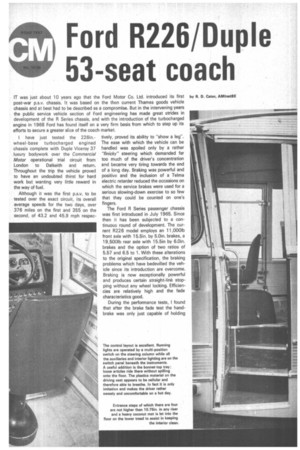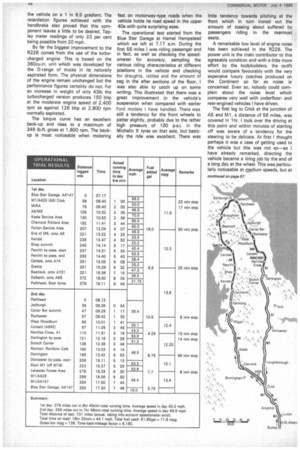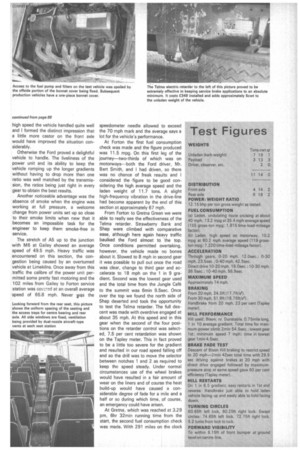Arp", Ford R226/Duple
Page 89

Page 90

Page 99

Page 100

If you've noticed an error in this article please click here to report it so we can fix it.
**111W 53-seat coach
1T was just about 10 years ago that the Ford Motor Co. Ltd. introduced its first by R. D. Cater, AIVIInstBE
post-war p.s.v. chassis. It was based on the then current Thames goods vehicle chassis and at best had to be described as a compromise. But in the intervening years the public service vehicle section of Ford engineering has made great strides in development of the R Series chassis, and with the introduction of the turbocharged engine in 1968 Ford has found itself on a very firm basis from which to step up its efforts to secure a greater slice of the coach market.
I have just tested the 226in.wheel-base turbocharged engined chassis complete with Duple Viceroy 37 luxury bodywork over the Commercial Motor operational trial circuit from London to Dalkeith and return, Throughout the trip the vehicle proved to have an undoubted thirst for hard work but wanting very little reward in the way of fuel.
Although it was the first p.s.v. to be tested over the exact circuit, its overall average speeds for the two days, over 376 miles on the first and 355 on the second, of 43.2 and 45.9 mph respec
tively, proved its ability to "show a leg". The ease with which the vehicle can be handled was spoiled only by a rather "finicky" steering which demanded far too much of the driver's concentration and became very tiring towards the end of a long day. Braking was powerful and positive and the inclusion of a Telma electric retarder reduced the occasions on which the service brakes were used for a serious slowing-down exercise to so few that they could be counted on one's fingers.
The Ford R Series passenger chassis was first introduced in July 1965. Since then it has been subjected to a continuous round of development. The current R226 model employs an 11,000lb front axle with 15.5in. by 5.0in. brakes, a 19,5001b rear axle with 15.5in by 6.0in. brakes and the option of two ratios of 5.57 and 6.5 to 1. With these alterations to the original specification, the braking problems which have bedevilled the vehicle since its introduction are overcome. Braking is now exceptionally powerful and produces certain straight-line stopping without any wheel locking. Efficiencies are relatively high and the fade characteristics good.
During the performance tests, I found that after the brake fade test the handbrake was only just capable of holding the vehicle on a 1 in 6.5 gradient. The retardation figures achieved with the handbrake also proved that this component leaves a little to be desired, Tapley meter readings of only 23 per cent being possible from 20 mph.
By far the biggest improvement to the R226 comes from the use of the turbocharged engine. This is based on the 360cu.in. unit which was developed for the D-range of trucks in its naturally aspirated form. The physical dimensions of the engine remain unchanged but the performance figures certainly do not. For an increase in weight of only 43Ib the turbocharged version produces 150 bhp at the moderate engine speed of 2,400 rpm as against 128 bhp at 2,800 rpm normally aspirated.
The torque curve has an excellent back-up and rises to a maximum of 349 lb.ft. gross at 1,800 rpm. The backup is most noticeable when motoring fast on motorway-type roads when the vehicle holds its road speed in the upper 40s with quite surprising ease.
The operational test started from the Blue Star Garage at Hemel Hempstead which we left at 7.17 a.m. During the first 55 miles I was riding passenger and in fact, as well as checking the speedometer for accuracy, sampling the various riding characteristics at different positions in the vehicle and checking for draughts, rattles and the amount of sag in the after sections of the floor, I was also able to catch up on some writing. This illustrated that there was a great improvement in the vehicle's suspension when compared with earlier Ford models I have handled. There was still a tendency for the front wheels to patter slightly, probably due to the rather high pressure of 100 ps.i. in the Michelin X tyres on that axle, but basically the ride was excellent. There was little tendency towards pitching at the front which in turn ironed out the amount of tossing about suffered by passengers riding in the rearmost seats.
A remarkable low level of engine noise has been achieved in the R226. The power unit is the main contributor to this agreeable condition and with a little more effort by the bodybuilders, the outfit would compare favourably with the very expensive luxury coaches produced on the Continent so far as noise is concerned. Even so, nobody could complain about the noise level which compares very well with underfloorand rear-engined vehicles I have driven.
The first leg to Crick at the junction of A5 and Ml, a distance of 56 miles, was covered in 1 hr. I took over the driving at this point and within minutes of starting off was aware of a tendency for the steering to be delicate. At first I thought perhaps it was a case of getting used to the vehicle but this was not so-as I have already remarked, directing the vehicle became a tiring job by the end of a long day at the wheel. This was particularly noticeable at medium speeds, but at
high speed the vehicle handled quite well and I formed the distinct impression that a little more castor on the front axle would have improved the situation considerably.
Otherwise the Ford proved a delightful vehicle to handle. The liveliness of the power unit and its ability to keep the vehicle romping up the longer gradients without having to drop more than one ratio was well matched by the transmission, the ratios being just right in every gear to obtain the best results.
Another noticeable advantage was the absence of smoke when the engine was working at full pressure, a welcome change from power units set up so close to their smoke limits when new that it becomes an impossible task for the engineer to keep them smoke-free in service.
The stretch of A5 up to the junction with M6 at Gailey showed an average speed of 49.5 mph. Heavy traffic was encountered on this section, the con gestion being caused by an overturned vehicle at Limekilns. Once away from this
traffic the calibre of the power unit permitted some pretty fast motoring and the 102 miles from Gailey to Forton service station was cov:7:-ei at an overall average speed of 65.8 mph. Never vas the
speedometer needle allowed to exceed the 70 mph mark and the average says a lot for the vehicle's performance.
At Forton the first fuel consumption check was made and the figure produced was 11.5 mpg. On this first leg of the journey—two-thirds of which was on motorways---both the Ford driver, Mr. Bert Smith, and I had driven, so there was no chance of freak results and I considered the -figure to be good considering the high average speed and the laden weight of 11.7 tons. A slight high-frequency vibration in the drive-line had become apparent by the end of this section at approximately 67 mph.
From Forton to Gretna Green we were able to really see the effectiveness of the Telma retarder. Strawberry Bank and Shap were climbed with comparative ease, although here again heavy traffic baulked the Ford almost to the top. Once conditions permitted overtaking, however, the vehicle made no bones about it. Slowed to 8 mph in second gear it was possible to pull out once the road was clear, change to third gear and accelerate to 18 mph on the 1 in 9 gradient. Second was the lowest gear used and the total time from the Jungle Café to the summit was 6min 9.5sec. Once over the top we found the north side of Shap deserted and took the opportunity to test the Telma retarder. The full descent was made with overdrive engaged at about 35 mph. At this speed and in this gear when the second of the four positions on the retarder control was selected, 7.5 per cent retardation was shown on the Tapley meter. This in fact proved to be a little too severe for the gradient and resulted in our road speed falling off and so the drill was to move the selector between notches 1 and 2 as required to keep the speed steady. Under normal circumstances use of the wheel brakes would have resulted in a fair amount of wear on the liners and of course the heat build-up would have caused a considerable degree of fade for a mile and a half or so during which time, of course, an emergency could have arisen.
At Gretna, which was reached at 3.29 pm, 6hr 32min running time from the start, the second fuel consumption check was made. With 291 miles on the clock
the second section had produced a figure of 12.2 mpg-0.7 mpg better than the first section. Leaving Gretna after a stop of 29min I took over the driving again for the last leg of 85 miles to Dalkeith. This part of the route runs through the Tweedsmuir hills on A701. A fairly narrow and twisty road for a great deal of its length, it was the section that revealed most clearly the shortcomings of the steering gear, As I drove through Moffat and onto the first of the really narrow sections we had encountered on the route I found almost 100 per cent concentration necessary in order to keep the vehicle in its own half of the road without getting the nearside wheels into the kerbless soft ground at the edge. Until one has experienced, as I did some 20 years ago, the disastrous effect of such a mistake, one is inclined to ignore the problem, but it can prove as dangerous as a head-on collision and should not be underrated.
The remainder of the vehicle's handling qualities assisted greatly to keep the average speed up to 36.5 mph over the narrow roads. This was exactly 3 mph slower than the last passenger vehicle that I drove over the section which had a maximum power output of 125 bhp and scaled almost one ton less than the Ford.
Dalkeith was reached at 6 p.m. and the overnight stop at the Stair Arms, Pathhead, four miles farther down the road I1min later.
By the time we were parked I had formed three firm conclusions. I had seen the turbocharged 360 engine perform a hard day's work without the slightest sign of stress—and very economically too. The vehicle as a whole had proved corn fortabie both to drive and ride in as a passenger. Here, I thought, was the first low-priced p.s.v. chassis I had handled which might well keep pace under service conditions with its more highly priced counterparts. But, the second day of the test, the first 96 miles of which would really prove the vehicle's worth, would either confirm or shatter my first impressions.
At 8.12 a.m. the next day we left Pathhead. The ambient temperature was about 45deg F and the engine started instantaneously and idled reliably. Carter .Bar summit was reached at 9.29 a.m. after a climb when the speed never dropped below 14 mph with third gear engaged. The total time taken for the 1.82-mile climb was 4min 20sec and the road speed at the start was 36 mph while at the summit it was 22 mph.
At Rochester a consumption check for the section from Gretna was made: this proved to be 13.6 mpg. While shunting the vehicle to the fuel pump at this point I noticed for the first time a tendency for the front brakes to grab at very low speeds.
The next section of the route from West Woodburn via Consett to Darlington is very severe and includes two gradients of around 1 in 5. The first of these at Riding Mill-0.6-mile long and 1 in 5 maximum—was surmounted in 2min lOsec, the lowest gear used was fi rst and the lowest speed recorded 4 mph. That the climb took such a short time shows just how well the vehicle recuperates on a gradient. After being pulled down to 4 mph I found it possible to change up two gears and clear the top of the climb at 16 to 17 mph. The picture was the same at Castleside (steepest section 1 in 5.25l where the 0.8-mile climb was completed in 3min 51 sec. Again the lowest gear was first and the lowest speed 4mph, but recuperation was such that I was once more able to change up and bring the speed back to 15 or 16 mph. Fuel consumption over this part of the route worked out at 12.25 mpg.
The rest of the journey, mainly over motorway and Al (NC was a reflection of the day before. Only the 30 mph south-westerly winds changed the picture slightly in that the fuel consumption was not so good as that obtained on the journey northwards.
We arrived back at Hemel Hempstead at 5.54 p.m. after completing the 355-mile journey in 7hr 48min running time at an average speed of 45.9 mph. During this day's running the rear axle had developed a bit of a moan and the high-frequency vibrations of the day before were still evident, emanating from somewhere in the drive-line. Both the Ford man and myself traced this to the Telrna retarder, as the same condition could be raised when this was switched in at speed as low as 40 mph.
Duple has excelled itself with the Viceroy 37 body. Not only does it have a very pleasing appearance but with 49 seats in the test vehicle instead of the design figure of 53, there was ample leg room for passengers and general high standard of comfort. Ventilation was good and apart from the entrance door the body is completely free of rattles.
As tested complete with Duple body and Telma retarder, the Ford 8226 360 Turbo-engined coach costs £7,027.




























































































































































